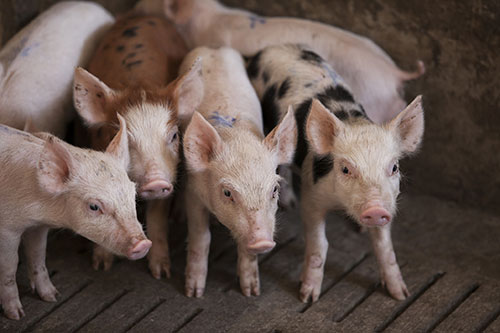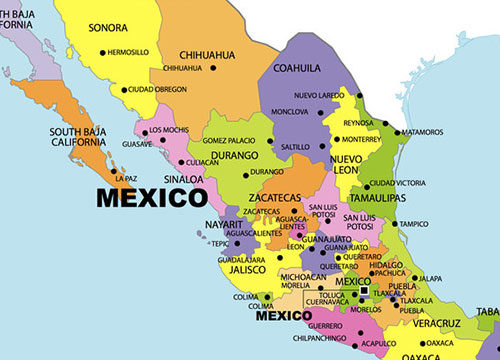



Effects of Porcine Epidemic Diarrhea in Latin America
The porcine epidemic diarrhea virus outbreak in the US in 2013-2014 is widely known. However, at that same time, the Mexican and Colombian swine industries dealt with their own crippling PEDv outbreaks. A series of poster presentations dealt with this topic at the 24th International Pig Veterinary Society Congress, Dublin, Ireland, June 2016. C. Corzo from PIC and D. Linhares, Iowa State University, Ames, United States, quantified the speed of recovery and measure total production loss in terms of piglets not weaned due to PEDv in Latin American breeding herds undergoing virus control and elimination.
C. Corzo from PIC and D. Linhares, Iowa State University, Ames, United States, quantified the speed of recovery and measure total production loss in terms of piglets not weaned due to PEDv in Latin American breeding herds undergoing virus control and elimination.
The speed and discipline with which strategies to control porcine epidemic diarrhea virus (PEDv) are implemented in a production system are important from a financial standpoint, as PEDv-positive flows have gotten worse throughout, affecting growth and feed efficiency.
Production records containing number of pigs weaned per week from 24 pig farms that had no previous history of PEDv were obtained. Records contained data before and after PEDv detection. Previously described statistical process control (SPC) methods were used to calculate time-to-baseline-productivity (TTBP) and total piglets not weaned/sow (Total Loss) for each herd (Linhares & Morrison, 2014).
The overall average TTBP was 10 ± 4.6 ranging between 6 and 22 weeks. Large sow herds (i.e. ≥ 1000) compared to small herds had a TTBP of 12 and 7.8, respectively. Most of the small herds were under a batch farrowing production system; however, there was no difference in TTBP when weekly and batch farrowing production farms were compared. The overall average total per sow was 2.65 ± 1.72 ranging between 0.8 and 8.1. The correlation between TTBP and total loss was 0.44.
The TTBP for Latin American farms undergoing PEDv control and elimination was similar to what has been previously reported by Goede and Morrison in 2015 on US herds. An important variation was found on TTBP. We believe that farms lacking implementation consistency of recommended practices for PEDv control and elimination took longer to reach initial production.
In this study, TTBP and total loss revealed a high variability component among farms which may be explained by the way the control and elimination procedure is conducted.

Identification of Porcine Epidemic Diarrhea Virus Associated with the 2014 Outbreak in Mexico
M. E. Trujillo-Ortega and colleagues from National Autonomous University of Mexico indicated that during 2013 the PEDv outbreak in the United States caused up to 100 % mortality in piglets. In Mexico, in March 2014 the first outbreak of PED was detected in the State of Mexico with 100 % mortality in piglets. The aim of this study was to confirm and identify the PEDv, from samples of piglets using molecular techniques and electron microscopy.
Euthanasia and necropsy was performed and samples obtained where lung (13), stomach content (13), stomach (13), small intestine (8), and feces (15). Along with the electron microscopy, the presence of virus in clinical samples was confirmed by RTPCR, amplifying the S gen.
Macroscopic and microscopic lesions were suggestive of acute infection with PEDv. The morphology and size of the viral particles coincides with the characteristics of coronavirus. Of a total of 62 samples, 32 were positive (51.61%), 9 lungs (69.23%), 13 of stomach content (100%), 4 stomach (30.76%), 5 small intestine (62.5%), 1 feces (6.66%).
The nucleotide sequence analysis of the isolated virus of the 2014 outbreak in Mexico showed a marked homology to viruses that circulated in 2013 in Colorado, USA.

PEDv Genetic Analysis in Mexico
J. Lara and colleagues from Laboratorio Avi-Mex in Mexico performed a sequence analysis using samples obtained from different states of the country with the objective of generating information regarding PED genotypes present in Mexico.
The results of S1 region sequence from one-hundred-one PED viruses obtained between January 2014 and February 2015 were analyzed. Ninety-eight samples originated from six different states and three additional samples from 2013 were included. The sequence of the Illinois 63-2013 PED virus was used in order to compare our national sequences.
The results show the presence of three main branches and more than forty clades as compared to the original type virus (Illinois 63- 2013). Branch 1 contains sequences detected from the mid-western state of Jalisco; branch 2 from Jalisco and also from the north-western state of Sonora; and branch 3 from the state of Jalisco, the central states of Morelos, Mexico, Puebla and also from the state of Veracruz in the Gulf of Mexico.
Using the genetic distances of the analyzed sequences, we found that branch 3 has the widest genetic differences among all samples, with sequences with a variation of up to 1.5%.
From one-hundred-one samples, three branches were identified. One sequence from Veracruz (2014) and one sequences from Jalisco (2015) showed a genetic distance of 1.5% like a possible representative of the virus evolution or continuous adaptation process. The rest of the samples remained within a close homology to the original virus Illinois 63-2013.
Effect of Two PED Vaccines on Prewean Mortality Under Field Conditions in Mexico
A group of researchers from Granjas Carroll de Mexico, Iowa State University, Instituto Tecnologico de Conkal, and Zoetis assessed the effect of two vaccines against PED (manufactured by ZoetisTM and HarrisvaccinesTM respectively) compared to no vaccination.
During a multi-site outbreak that occurred in March, 2015, the vaccines were applied in sows and gilts and unvaccinated controls were also kept. Both PED vaccines were used according to their label directions (intramuscular injection, pre-farrowing). Diagnostic testing revealed that some sites were affected by the prototype PED virus and others with the Indel strain.
All vaccinated groups showed low premortality weaning and better piglet quality. Gilts (1st farrow) yielded smaller litters and had higher mortality rates than sows (2nd farrow or greater). Animals in the control group had more deaths per litter than those treated with either vaccine.
Differences between challenge strains were found for pigs weaned, number of deaths and mortality rate per litter (9.1 vs 6.7; 3.1 vs 5.0 and 25.8 vs 42.3 for Indel and Prototype strains), although these differences could also have been influenced by site factors.
The use of either PED vaccine reduced prewean mortality independently of challenge strain (Indel or Prototype viruses). PED vaccines can help to reduce negative impact of PED disease in infected herds. The use of the vaccines is an excellent tool to control the disease in addition to biosecurity measures.
PED Vaccine Effect on Immunoglobulin Production
This same group of researchers then studied the effect of those same two vaccines on immunoglobulin production in pigs.
The study was conducted during a PED outbreak in March 2015 and assessed the effect of two PED vaccines (manufactured by Zoetis and HarrisvaccinesTM) on the secretion of anti-PED IgA and IgG in comparison to a non-vaccinated control group. The vaccines were applied according to the manufacturers’ directions (intramuscular injection pre-farrowing), but with some animals receiving two doses and some only one. Colostrum samples were taken aseptically from sows and gilts after farrowing.
Parity did not affect titers of IgA, but there was a difference between gilts and mature sows in IgG. The vaccinated groups had higher titers of IgG and IgA. Titers of IgG and IgA increased with time after vaccination. Doses affected the amount of IgG and IgA. Differences were found among challenge strains (Indel and Prototype) for IgG and IgA (1.33 vs 1.75) (P<0.05).
Both vaccines stimulated IgA and IgG independently of challenge strain. Parity influences immunoglobulin levels with gilts producing less than sows, consistent with the belief that gilts are less efficient at immunoglobulin production.
Diagnosis of PEDv in Colombian Swine Farms
J. D. Mogollon, and colleagues from the Colombian Agricultural Institute (ICA - Instituto Colombiano Agropecuario) and National University of Colombia reported the detection of PEDv in natural outbreaks in Colombian swine farms.
Samples from 186 pig farms in Colombia from March 2014 through December 2015 were submitted to the National Veterinary Laboratory of ICA. All of the pig farms had similar disease histories, clinical signs, and lesions, including the presence of a sudden outbreak and rapid spread between farms, high mortality in neonatal piglets. Affected piglets displayed anorexia, vomit, diarrhea, and dehydration.
Clinical specimens were collected and tested by rRTPCR. Samples from 10 cases were sent to NVSL USDA to reconfirm our diagnosis and also to conduct preliminary sequencing.
A total of 149 pig farms was confirmed as positive for PEDV by qPCR. Microscopic intestinal lesions consistent with viral enteritis were observed in all cases examined. The PEDv antigen was found in the cytoplasm of villous enterocytes in acute cases studied. Ten PEDv strains sequenced in NVSL were found 99 to 100% identical to the NPL-PEDv USA isolates detected in 2013 and 2014.
The data demonstrated that PEDv is now endemic in Colombia. So far the virus has been detected in 10 departments of the main pig production regions. PEDv isolates are genetically similar to US isolates. These strains were responsible for the recent PEDV outbreak in our country and they produced a similar mortality and pathological findings as reported for the US isolates. The source of this emergent PEDv in Colombia is still unknown.

Pig Transportation as a Key for Dissemination and Maintenance of PEDv Infection in Colombia
D. S. Vargas Bermudez and colleagues from the National University of Colombia (Universidad Nacional de Colombia) in Bogota noted that PEDv was first reported in Colombia in early 2014. The goal of the research was to evaluate PEDv presence on porcine transportation trucks from 14 different regions of country as a contributing factor to the spread and maintenance of the disease in Colombia.
Environmental samples were collected from 520 trucks employed to transport live pigs destined for slaughterhouses. The samples were taken at two moments: upon arrival and after unloading from the abattoir (when trucks were disinfected). Samples were collected from June to October of 2014. The study included 32 abattoirs from 14 Colombian departments.
In total, 483 of 520 trucks (92.8%) were contaminated upon arrival and 468/520 trucks remained contaminated after unloading. Only 7% of the trucks were not contaminated with PEDv upon arrival from the abbatoir. Samples from positive trucks showed the same cycle threshold values at arrival and departure.
There were high viral loads of PEDv in departments where swine production is highest, such as Cundinamarca, Valle del Cauca, and Antioquia. PEDv was found in 8/14 departments (57%) and 17/32 slaughterhouses (53%).
This study also showed that 57% of the positive samples had low viral loads (1x104 copies).
This study suggests that trucks can be an efficient source of dissemination of PEDV between farms and departments. The low viral load found in the majority of the samples shows that although the virus is circulating in Colombia, it is not showing fatal signs of illness.
Photos: Shutterstock








